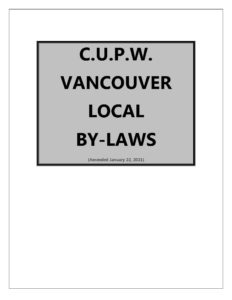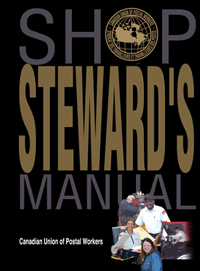If you or any of your eligible dependents (your spouse, or your children under 18, or 18-25 year of age, full time at post secondary education) need glasses, get them now. This is because the current four year period for our vision plan ends on December 31, 2018. If you have not used your entitlement for this current four year period it will evaporate. Continue reading “GET YOUR EYE GLASSES BY DECEMBER 31, 2018.”
Local By – Laws
The Collective Agreement
 |
The Agreement between Available in PDF format HERE
|
Personal Days Payout or Carry over – FAQ
Personal Days Payout or Carry over – FAQ
- What happens if I don’t use up all of my Personal Days in any one calendar year?
- How many Personal Days can I carry over?
- What do I do if I want to be paid out for all my eligible unused days?
- What do I do if I want to carry over all my eligible unused days?
- Do I have to carry over or be paid out for all my eligible unused Personal Days or can I be paid for some and carry over the rest?
- Can I carry over less than one day?
- Can I be paid out for less than one day?
- What salary rate is used when Personal Days are paid out?
What happens if I don’t use up all of my Personal Days in any one calendar year?
At the end of each calendar year, you can be paid out for your unused Personal Days, carry over up to 5/7 of your annual allotment or a combination of both.
How many Personal Days can I carry over?
The maximum number of Personal Days you can carry over is equivalent to 5/7 of your yearly allotment. For example, if your yearly allotment of Personal Days is seven, you can carry over a maximum of five.
What do I do if I want to be paid out for all my eligible unused days?
You don’t have to do anything. All Personal Days that remain unused at the end of the year will automatically be paid out to you with the third pay of the New Year. Please note that this payment is taxable and will include applicable deductions, including employment insurance and Canada Pension Plan. This payment is non-pensionable under the Canada Post pension plan.
What do I do if I want to carry over all my eligible unused days?
Between December 1 and 31 each year, you will be able to use the Personal Days Carry-Over Tool on Employee Self Service (ESS) to carry over the maximum of 5/7 of your annual allotment of Personal Days into the following year .
Do I have to carry over or be paid out for all my eligible unused Personal Days or can I be paid for some and carry over the rest?
Yes. You can carry over some of your unused Personal Days and get paid for the rest.
Between January 1 and 7, you can use the Personal Days Carry-Over Tool on ESS to carry over a specific number of your unused Personal Days (up to a maximum of 5/7 of your annual allotment of Personal Days). The rest of your unused Personal Days will automatically be paid out to you with the third pay of the New Year, subject to all applicable taxes and deductions. For example, if you have five Personal Days remaining that are eligible to be carried over or paid out, you can choose to carry over between one and five days and be paid out for the remaining days.
If you are unable to access the Carry-Over Tool on ESS, you can use the carry-over form, which is available on the Short-Term Disability Central website on Intrapost and submit it before January 7 of the following year, to indicate the specific number of hours you want to carry over. Any remaining Personal Days will automatically be paid out to you with the third pay of the New Year, subject to all applicable taxes and deductions.
Can I carry over less than one day?
Yes. Personal Days are counted in hours and you can choose to carry over however many or few hours as you wish up to a maximum of 5/7 of your yearly allotment of Personal Days.
Can I be paid out for less than one day?
Yes. Personal Days are counted in hours and you may be paid out for full or partial days.
What salary rate is used when Personal Days are paid out?
The amount of your payment is based on your salary as of the last day of the fiscal year, which is December 31.
Is the payment for unused Personal Days pensionable?
No.
Is the payment for unused Personal Days taxable?
Yes. The payment is taxable and will include all usual source deductions, including employment insurance and Canada Pension Plan.
When will I receive payment for any unused Personal Days?
You will receive your payment with the third pay of the New Year.
When my Personal Days are paid out will the payment show as a separate line on my pay stub?
Yes. Your Personal Days payout will appear as a separate line, which will read “Personal Days Payout” on your pay statement.
What happens if I choose to carry over or be paid out for all my eligible unused Personal Days, but then use some at end of December?
If the Personal Days you take at the end of December are recorded in a timely manner (that is before the PP03 cut-off date) payment for your unused Personal Days or the number of Personal Days that are carried over will automatically be adjusted.
If I have Personal Days that I carried over from a previous year, can I ask at any time to have them paid out?
No. You have to wait until the end of each year to be paid out for eligible unused Personal Days.
If I carry over days from the previous calendar year, will the number of carried-over Personal Days be listed separately from the current year’s Personal Days?
Yes.
What is the maximum number of Personal Days I can hold in any one year?
The maximum number of Personal Days that an employee can have in any given year is 12.
My allocation of Personal Days for the year was less than seven. How many days can I carry over at the end of the year?
You can carry over a maximum of 5/7 of your yearly allotment of Personal Days. For example:
- If your yearly allotment was equivalent to six Personal Days, you can carry over 4 days. You will paid for .28 days.
- If your yearly allotment was equivalent to five Personal Days, you can carry over 3 days. You will be paid out for .57 days.
Can I carry over partial days?
No. You can carry over full days only. Any remaining partial days will be paid out to you with the third pay period of 2013, subject to all applicable taxes and deductions.
Personal Days – FAQ
Personal Days
What are Personal Days?
Personal Days are a paid leave benefit that can be used in a variety of ways, including time off for illness, medical appointments (for employees or to accompany family members), personal reasons and urgent situations, as well as to satisfy the waiting period for income-replacement benefits.
At the beginning of every calendar year, eligible full-time employees receive up to seven Personal Days. Eligible part-time and term employees receive a pro-rated equivalent.
Do I need to give a reason when I request a planned/non-urgent Personal Day?
No.
What is a leave form?
A leave form must be completed and given to your team leader in advance if you’re requesting a planned/non-urgent Personal Day, or upon your return work if you’ve reported an urgent Personal Day.
How can I find out how many Personal Days I have left?
You can check how many Personal Days you have left by visiting Employee Self Service (ESS). Select MySAP and then choose ESS from the drop-down menu. Once in ESS, select the Time Management tab at the top to see all your leave balances.
Do employees have to take all vacation days before using their Personal Days?
No. Employees do not need to use all of their vacation days before using their Personal Days.
How far in advance can I book a Personal Day?
You can book a planned/non-urgent Personal Day three days, but no more than three months before the day requested.
If many people ask for the same day off, is seniority used to make a decision?
No. Personal Days for planned/non-urgent situations are granted on a first-come, first-served basis.
Can I take as many planned/non-urgent Personal Days consecutively as I want at one time?
Yes, as long as the Personal Days requested are convenient to the employee and the Corporation.
Do I have to use Personal Days in full days?
No. Personal Days can be taken in increments as little as two hours.
Are there any ‘black-out’ periods for Personal Days?
No. However, requests for planned/non-urgent Personal Days are approved only if the requested Personal Days are convenient to the employee and the Corporation. If a Personal Day request cannot be approved, an alternative solution should be sought between you and your team leader. For example, perhaps you could take a partial day off (in two-hour increments) rather than a full day.
Once my Personal Day has been approved, can this approval be changed?
Yes it can. However, once a Personal Day request is approved, Canada Post will make every reasonable effort to respect it and will change it only under exceptional circumstances.
What happens if my request for a planned/non-urgent Personal Day isn’t approved?
Team leaders are encouraged to approve as many planned/non-urgent Personal Day requests as possible while still taking into consideration the requirements of their operation. If a Personal Day cannot be approved an alternative solution should be sought between you and your team leader. For example, perhaps you could take a partial day off (in two-hour increments) rather than a full day.
Who will enter any Personal Days that I take into SAP?
Team leaders will continue to enter time in SAP.
What happens if I don’t use all of my Personal Days in any one year?
At the end of each calendar year, you can be paid out for your unused Personal Days, carry over up to 5/7 of your annual allotment or a combination of both.
Are Personal Days pro-rated?
Yes. Personal Days are pro-rated based on an employee’s scheduled hours and the length of his or her term. It’s important to remember that you can carry over a maximum of 5/7 of your yearly allotment. For example, if your yearly allotment of Personal Days is seven, you can carry over a maximum of five days. However, if your yearly allotment of Personal Days is six, you can carry over only 4.28 days, and if your yearly allotment is five days, you can carry over only 3.57 days. Unused Personal Days in excess of this 5/7 maximum cannot be carried over.
At the end of each year, how will I tell you what I want to do with my unused Personal Days?
Between December 1 and 31 each year, you will be able to use the Personal Days Carry-Over Tool on Employee Self Service (ESS) to carry over all eligible unused Personal Days (5/7 of your current year’s allotment) into the next year .
Between January 1 and 7, you can use the Personal Days Carry-Over Tool on ESS to carry over a specific number of your unused Personal Days (5/7 of your current year’s allotment).
If you are unable to access the Carry-Over Tool on ESS, you can use the carry-over form, which is available on the Short-Term Disability Central website on Intrapost and submit it before January 7, to indicate the specific number of hours you want to carry over.
If you do nothing, any Personal Days that remain unused at the end of the year will automatically be paid out to you with the third pay of the New Year. Please note that this payment is taxable and will include all usual source deductions, including employment insurance and Canada Pension Plan.
Can I use vacation or compensatory time instead of Personal Days to cover absences due to illness?
Not for absences of less than seven calendar days. However, if you are away from work for more than seven calendar days and your claim for Short-Term Disability benefits is supported by the disability-management provider, you can use compensatory time and vacation time to cover the waiting period for Short-Term Disability benefits if you do not have Personal Days or Top-Up Credits (if applicable) left.
If I get sick on vacation, can I change this to Personal Days?
Yes.
Can I change Personal Days to bereavement leave?
Yes, if a qualified bereavement leave arises at a time booked for a Personal Day.
Are Personal Days like vacation days in that I must have 10 paid days (full-time employees) or five paid days (part-time employees) in a month to get credit for them?
Yes. Your allocation of Personal Days will be adjusted if you do not have 10 paid days (full-time employees) or five paid days (part-time employees) in a month. Subtract 1/12 of your allocation of Personal Days for each month in which at least 10 paid days (full-time employees) or five paid days (part-time employees) were not paid.
Are Personal Days based on the calendar year or vacation year?
Personal Days are based on the calendar year (January 1 to December 31).
What is the difference between Personal Days and Top-Up Credits?
Personal Days are allocated at the start of every year to give employees paid time to cover illness, appointments, family responsibilities, the waiting period for Short-Term Disability benefits or any other personal needs they may have.
When you joined STDP, any sick-leave credits you had accumulated were converted (on a minute for minute basis) into Top-Up Credits. You can use your Top-Up Credits to:
- Top-up income-replacement benefits from 70 per cent to 100 per cent (or 95 per cent during the period you are scheduled to receive EI benefits), and
- Cover the seven-calendar-day waiting period if no Personal Days are available for a supported period of illnesses.
What happens if I leave Canada Post part way through the year, but have already used up all of my Personal Days?
Your allocation of Personal Days will be pro-rated and any Personal Days you have taken and to which you were not entitled to will be recovered.
I will be retiring on February 28. Am I eligible for any Personal Days for the year and, if so, how many?
Yes. You are entitled to a pro-rated number of Personal Days for the 59 days you were employed by Canada Post (from January 1 to February 28) or 0.16 of one year (59 divided by 365). If you are a full-time employee and your scheduled hours are 37.50 per week, your Personal Days entitlement would be 8.49 hours (1.13 days).
If I have Personal Days that I carried over from the previous year, can I ask at any time for them to be paid out?
No. You will have to wait until the end of the year to request payment. Payment will then be made to you with the third pay of the New Year.



